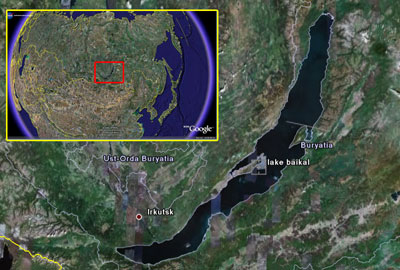Deepest-ever lake dive searches for new energy sources
Russians search for new energy source at bottom of Lake Baikal
mongabay.com
July 29, 2008
|
|
Russian scientists have reached the bottom of Lake Baikal, the world’s deepest lake, to take samples of gas hydrate deposits. Russia hopes the methane-rich deposits could someday be exploited as an energy source.
The expedition, which took place today and involved the manned submersibles MIR 1 and MIR 2, reached a depth of more than 1,680 meters (5500 feet). It is the deepest freshwater dive possible. The deepest marine dive was 10,912 (35,802 feet) in the Mariana Trench in 1960.
Expedition member Anatoly Sagalevich told AFP the expedition could turn up new species of wildlife living in the depths of the lake as well as gas and oil deposits under lake.
Gas hydrates, which consist of a crystalline lattice of water and methane molecules and are only stable only under low temperature and relatively high pressure, are usually found at the bottom of the ocean and in terrestrial permafrost. Bringing these solid methane ice deposits to the surface is difficult without them melting into methane gas.
 Map modified from a Google Earth image |
Globally the amount of carbon stored in gas hydrates is estimated at 10,000 gigatons. By comparison, fossil fuels store some 5,000 gigatons, land 2,790 gigatons, oceans 983 gigatons, and the atmosphere 3.8 gigatons, according to the U.S. Geological Survey (USGS).
Given the vast amounts of energy stored in hydrates, energy firms are increasingly interested in these deposits as a potential source of energy, but use of these icy methane deposits is currently fraught with problems, including inaccessibility, technical issues with handling the hydrates, and environmental concerns.
In the atmosphere, methane is 21 times more potent than carbon dioxide as a greenhouse gas. The exploitation of methane hydrate deposits could further drive global warming through carbon dioxide emissions resulting from increased burning of the fossil fuel as well as direct releases of the gas into the atmosphere.
Scientists say hydrate deposits may have played an important role in past climate change by causing fluctuations in atmospheric concentrations of greenhouse gases. The rapid decomposition of frozen methane hydrate deposits, possibly a result of higher ocean temperatures, may have been responsible for the sharp spike in atmospheric concentrations of greenhouse gases during the Palaeocene/Eocene thermal maximum (PETM) — a period of rapid, extreme global warming about 55 million years ago. The methane released during melting would have reacted with oxygen to produce huge amounts of carbon dioxide, also a potent greenhouse gas. The warming caused a mass extinction among marine animals and helped usher in the “Age of Mammals.”
At 25 million years old, Lake Baikal is much younger than the PETM event, but is still one of the world’s oldest lakes.